PACS: 25.80.Dj; 11.80.-m; 24.10.Ht.
1. Introduction
It is well-known that pion-nucleus elastic scattering has been of great importance in nuclear physics and other related disciplines. The pion’s properties of having a spin zero, an isospin one and a mass between the electron and the nucleon masses, make it the most useful probe of nuclear research 1. Contrary to other probes, as electrons and protons, the pion has both charges which makes it special in describing Coulomb effects and studying the charge-exchange scattering experiments. In particular, low-energy pions are of special interest and importance as they can penetrate deeply into the nucleus, and information about the nuclear interior can be obtained 2. This attribute is very important in gleaning nuclear information as nuclear structure and densities; in addition to other subtler aspects 3. Nevertheless, the low-energy pion-nucleus elastic scattering process contributes to the solution of pionic-atom problem, especially the explanation of the shifts and widths of the energy levels in pionic atoms 4. The significance of the low-energy pion-nucleus elastic scattering measurements remains incomplete without the complementary theoretical treatments. As alluded to in a previous study 5, several theoretical optical models, used in explaining the pion-nucleus elastic scattering data, faced a limited success. This provides a strong inducement to use our potential adopted in explaining successfully the measured differential and reaction cross sections for the elastically scattered low-energy negative pions from the same nucleus 12C 6.
When phase shift analyses are available for elastically scattered pions from certain nuclei, one can use the inverse scattering theory as a guide to extract potential points from available phase shifts 7. Then one can search for better potential parameters, by adjusting one parameter or more, that gives a reasonable agreement between the analytical forms of the potentials and the extracted potential points. This will be in conjunction with providing a nice explanation for the experimental angular distributions. The accuracy of the extracted potential points is affected by errors that obligatory exist in the phase shift analysis of the scattering data, and usually given as error bars. Alam 8 has highlighted all possible errors and provided valuable suggestions for reducing, but not eliminating, their effects.
So either the nonexistence of phase shift analysis or the unavoidable errors in the available phase shifts for pionnucleus scattering data limits, if not prevents, the use of the inverse scattering theory. This creates a strong motivation to search for an alternative method that gives approximate values, if not exact ones, for the potential parameters. For nucleus-nucleus and alpha-nucleus cases, the scaling method 9 has shown a reasonable success. With this in mind, we are trying to test the extent of success for a scaling method, or relatively a similar one, in obtaining approximate values for the potential parameters by scaling from one pionnucleus system to another nearby one in the same energy region. In this investigation, we try this method in obtaining the π+−16O potential parameters from the π+−12C potential parameters.
The following section briefs the theory. In its subsequent section, results and discussions for π+−16O and π+−12C systems, and the scaling method are outlined. The last section summarizes the conclusions.
2. Theory
The adopted nuclear potential here, VN(r), has the same analytical form used in our recent study 6:
i.e., it consists of a real part composed of an attractive WoodsSaxon and a repulsive squared Woods-Saxon terms, and an imaginary phenomenological attractive surface WoodsSaxon term, respectively. For an incident positive pion and a target nucleus, which is considered of a uniformly charged spherical distribution, the Coulomb potential term VC(r) is given by:
where ZT is the atomic number of the target nucleus, e2/4πε0 = 1.44 MeV.fm, ε0 is the permittivity of free space and Rc is the Coulomb radius. The total potential V (r) is the sum of nuclear and Coulomb potential terms:
To calculate the scattering amplitude, the differential and reaction cross sections, the potential V(r) is implemented in the radial part of Klein-Gordon equation:
In order to put Eq. (4) in a more convenient mathematical form, Rnl(r) is written as:
which assures the convergence of φnl(r) at the origin, i.e. limr→0φnl(r) = 0, and Eq. (4) becomes,
with k2 and U(r) are given by
where E, m, and c are the effective pion energy, effective pion mass, and the velocity of electromagnetic wave in vacuum, respectively. Using Numerov’s method, Eq. (4) is integrated numerically from the origin outward. As such the logarithmic derivative for the inner solution is obtained at the surface, i.e. at r = R where the nuclear part of the potential VN(r) vanishes. In contrast, the outer solution, i.e. for r ≥ R, where the potential is purely Coulomb, is well-known and is given by
where the relativistic versions of the regular and irregular Coulomb wave functions, Fℓ and Gℓ respectively, are used. These relativistic Coulomb wave functions are generated when the nuclear part is turned off in solving the radial part of Klein-Gordon equation 10,11. For a projected positive pion, the Sommerfeld parameter η is the defined by :
with α is the fine structure constant.
At the matching radius r = R, which is taken 5.4 fm and 6.0 fm for π+−12C and π+−16O, respectively, the inner and outer logarithmic derivatives are equated and complex phase shifts, δℓ, for all contributing partial waves, ℓ, are obtained. This makes it feasible to calculate the scattering amplitude f(θ), at angle θ in the center of mass system, using the formula:
where Pℓ(cosθ) is the Legendre polynomial, and σγ is the Coulomb phase shift defined by 12:
and the parameter γ is given by :
Knowing f(θ), the elastic differential cross section, dσ/dΩ, can be calculated using the formula:
In addition, one can easily calculate the reaction cross sections, σr, defined as:
where Sℓ = e2iδℓ is the S-matrix.
Benefiting from pion-12C, 16O available phase shifts 13,14 and the use of inverse scattering theory, with a complete relativistic treatment, in conjunction with obtaining a nice fit for available differential and reaction cross sections data within the framework of the relativistic Klein-Gordon equation, the real and imaginary parameters of the potentials were determined. The inverse scattering theory, used as a guide for extracting potential points from available phase shifts, was fully explained 15 and, as such, will not be repeated here.
3. Results and Discussion
3.1. π+−12C Case
In a recent study 6 the π−−12C elastic scattering data has been successfully analyzed by using a three-term simple local optical potential obtained by using inverse scattering theory, as a guide, from available phase shifts. As such, and following the same strategy, we started by analyzing the π+−12C elastic scattering data in the same low-energy region. As indicated in Table I, six potential parameters, V0 = −37.0 MeV, a0 = 0.324 fm, R1 = 3.00 fm, a1 = 0.333 fm, R3 = 1.70 fm and a3 = 0.370 fm, were kept fixed and the other three parameters, R0, V1 and W3, were changed with the pion’s incident kinetic energy, Tπ, to provide a nice agreement between measured and calculated differential and reaction cross sections. The analytical forms of these potentials, along with the extracted potential points from available phase shifts 13,16 are shown in Fig. 1 at all energies considered herein. In Fig. 2, and by using these potentials, our calculated differential cross sections are compared with the experimental ones 16,17,18,19,20,21,22,23,24. The agreements are very satisfactory. In addition, our calculated reaction cross sections at all energies under consideration, compared to the available experimental ones, are shown in Table I. Unfortunately, the available experimental and theoretical reaction cross sections 4,25,26,27,28 are cloudy and uncertain; and even with no agreement on their increasing behavior with energy 29. In addition, the situation is more corrupted if one compares the reported reaction cross sections at 30 MeV 4,30,31 shown in Tables I and II as the value for the carbon case is almost two to three times as that for the oxygen case.
Table I The changed three potential parameters R0(in fm), V1(in MeV) and W3(in MeV) used in Eq. (1) for incident positive pions with energies Tπ (in MeV) noted in column one and incident on carbon-12 target. Other potential parameters, also given in Eq. (1), are kept fixed with the values V0 = −37.0 MeV, a0 = 0.324 fm, R1 = 3.00 fm, a1 = 0.333 fm, R3 = 1.70 fm and a3 = 0.370 fm. Our calculated reaction cross sections, σr (theor) in millibarns, compared to the available experimental ones, σr (exp t) in millibarns, are listed in columns 5 and 6, respectively. The last column shows the references for available σr (exp t).

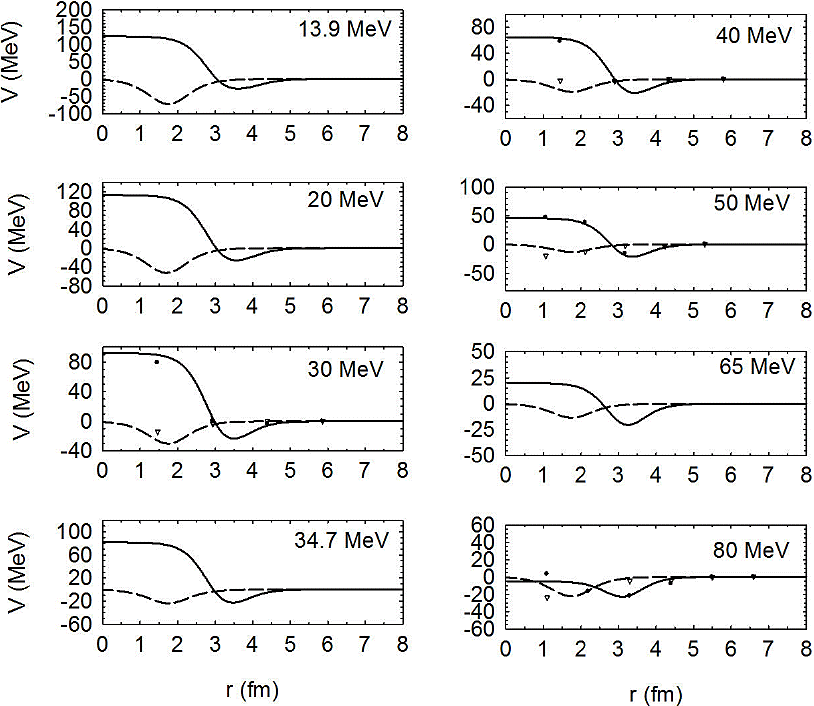
Figure 1 The real (solid line) and imaginary (dashed line) parts of the potentials used in analyzing π+−12C elastic scattering data at the indicated eight pion’s incident kinetic energies. Where available, the analytical forms of the real and imaginary parts of the potentials are compared with the real and imaginary potential points, shown as solid circles and empty triangles, respectively, extracted from available phase shifts 13,16 using inverse scattering theory.
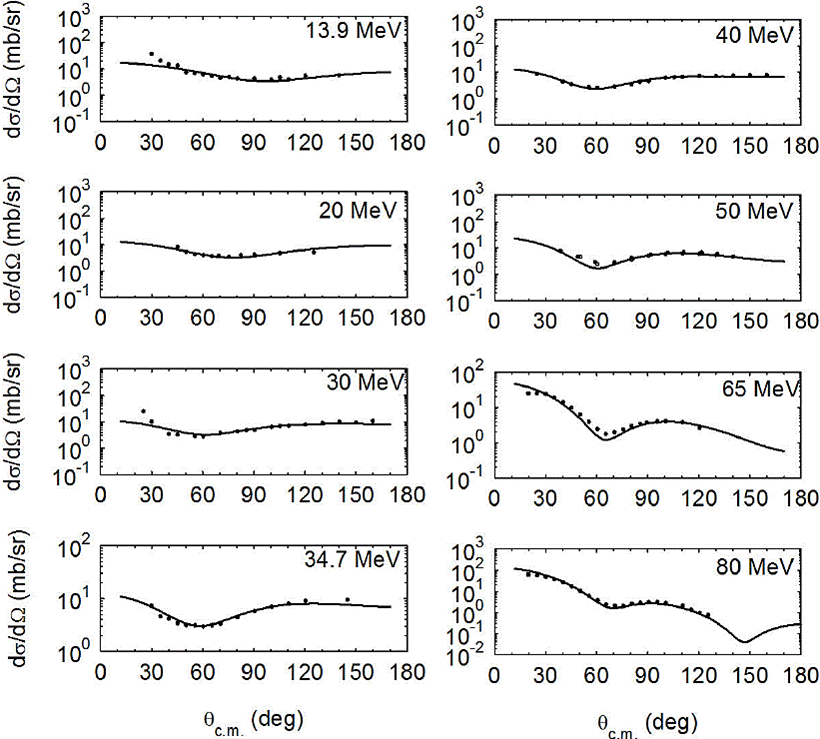
Figure 2 Our calculated differential cross sections represented by solid lines, using our potentials in Fig. 1, are compared with the measured ones 16-24 at the indicated eight pion’s incident kinetic energies.
Unfortunately this is an outrageous contradiction, but still acceptable compared to the more valuable and positive results. As such, the priority here is given for the ability of the potential to provide a nice agreement between predictions and experiment for elastic differential cross sections rather than reaction cross sections. In principle, this forms a stringent test for the correctness and success of the potential. Nevertheless, and in our investigation, one can also notice that the calculated reaction cross sections simulate the corresponding changes in the strength of the imaginary pat, W3. This is highly expected as both represent the opening of inelastic channels.
Concerning the three potential parameters (R0, V1, W3) that change with Tπ , it is found that both R0 and V1 change linearly, while W3 changes quadratically, with Tπ as clearly represented in Figs. 6, 7 and 8. By applying a spline fit for each of these graphs, the following corresponding relations are obtained:
It is clear that the V1−Tπ relation in (17) is different from the corresponding one obtained for the π−−12C scattering case 6. This consolidates the need for different, although close, potentials in explaining the elastic scattering data for pions with both charges. This is also supported by the obtained values, and the corresponding relations, for R0 and W3.
3.2. π+−16O Case
The success of our potential in explaining the π+−12C elastic scattering data forms an inducement to use it in analyzing the π+−16O. This has been carried out in a similar fashion as phase shift analyses are available at most, if not all, energies under consideration. This enables the use of the wellestablished inverse scattering theory, for the elastic scattering of two non-identical particles, to be used as a guide in determining the potential parameters. The obtained potential parameters consist of six fixed parameters with the values V0 = −37.0 MeV, a0 = 0.324 fm, R1 = 3.00 fm, a1 = 0.333 fm, R3 = 1.87 fm and a3 = 0.370 fm; and the three changed parameters R0, V1 and W3. All these parameters are indicated in Table II. The analytical forms of the potentials, real and imaginary parts, are plotted in Fig. 3. These potentials, real and imaginary parts, are reasonably compared with the potential points, solid circles and empty triangles, respectively, extracted from available phase shifts 14,31 using inverse scattering theory. Using these potentials, with only three free parameters, our calculated differential cross sections are in very good agreement with the experimental values at 30, 40 and 50 MeV 16,20 but slightly differ at forward angles for 20 MeV 19 and at large angles for 80 MeV 1 as clearly depicted in Fig. 4. It is worth to mention that all the fixed six parameters have the same values as for π+−12C case, but with a slight change in the absorption radius R3. As in the π+−12C case, our calculated reaction cross sections, compared to the experimental ones where available, are tabulated in Table II; and again the evidence on available experimental and theoretical values 4,16,26,31 is scanty. This is very obvious in the very large discrepancy in the total reaction cross sections of 166 and 284 mb, at 50 MeV for π+−16O case, reported by Meirav et al. 26 and Malbrough et al. 31, respectively. Hence, our calculated reaction cross sections are proposed pending further related studies.
Table II The changed three potential parameters R0(in fm), V1(in MeV) and W3(in MeV) used in Eq. (1) for incident positive pions with energies Tπ (in MeV) noted in column one and incident on oxygen-16 target. Other potential parameters, given in Eq. (1), are kept fixed with the same values as carbon-12 target, i.e. V0 = −37.0 MeV, a0 = 0.324 fm, R1 = 3.00 fm, a1 = 0.333 fm, R3 = 1.87 fm and a3 =0.370 fm. Our calculated reaction cross sections, σr (theor) in millibarns, compared to the experimental ones, σr (exp t) in millibarns, are presented in columns 5 and 6, respectively. The last column displays the references for available σr (exp t).

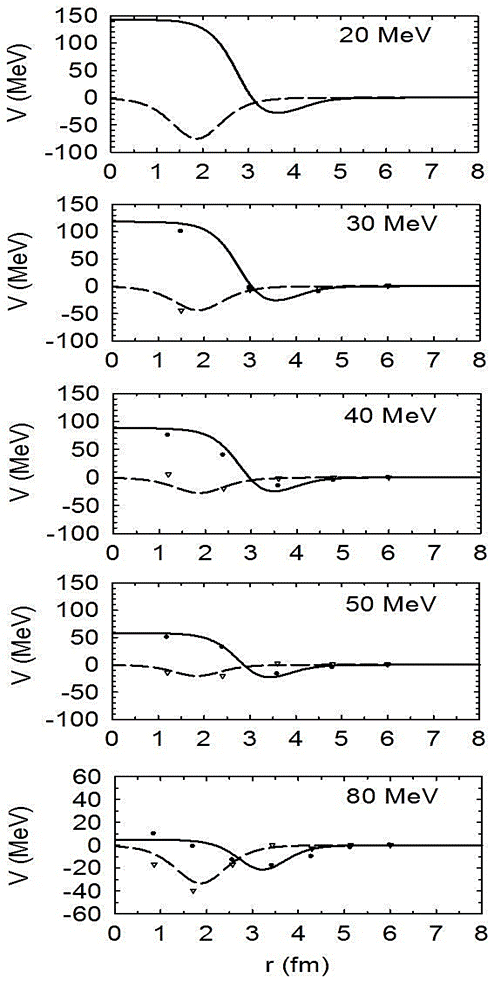
Figure 3 The real (solid line) and imaginary (dashed line) parts of the potentials used in analyzing π+−16O elastic scattering data at the indicated five pion’s incident kinetic energies. The analytical forms of the real and imaginary parts of the potentials are compared with the real and imaginary potential points, shown as solid circles and empty triangles, respectively, extracted from available phase shifts 14,34 using inverse scattering theory.
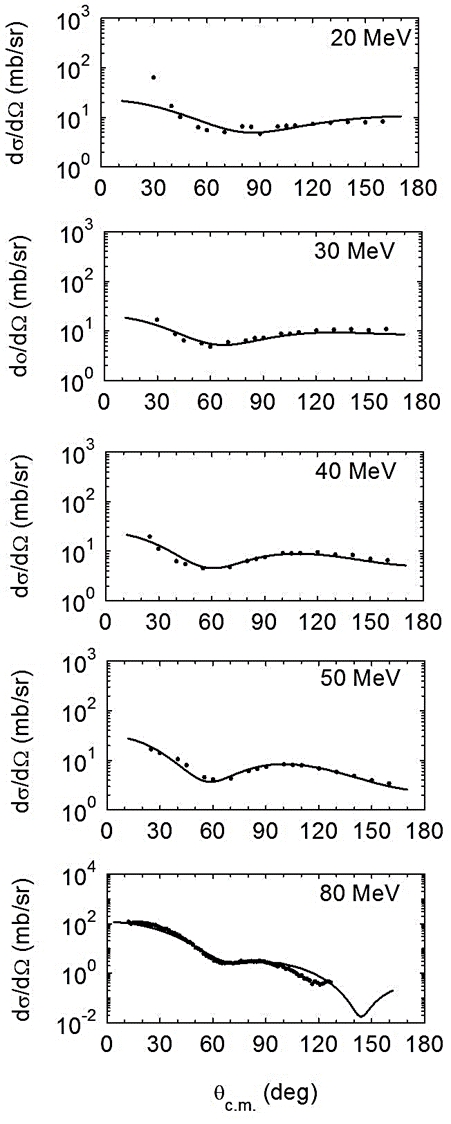
Figure 4 Our calculated differential cross sections represented by solid lines, using our potentials in Fig. 3, are compared with the measured ones at Tπ = 20 MeV 19, Tπ = 30, 40, 50 MeV 16,20 and Tπ =80 MeV 1 as indicated.
Again, applying a spline fit to each of the three changed parameters R0, V1 and W3 with Tπ reveals the following relations:
These three relations for π+−16O case are different from their counterparts given by Eqs. (16), (17) and (18) for π+−12C case. This strongly indicates the dependence of the parameters of these potentials on the atomic mass, A, of the target nucleus. So in comparison, and in connection, with the scaling method for none relativistic alpha-nucleus and nucleus-nucleus scattering cases, does a scaling method exist for pion-nucleus cases?
3.3. The Scaling Method
Scaling potential parameters of a certain nuclear system to another nearby one has been used with a reasonable success. It has been established that scaled potential parameters can predict the general feature of the cross section. It is worthwhile mentioning that the derived scaling relations rely on a strong theoretical background as they are connected to the well-known energy density functional (EDF) theory 7. In fact, Haider and Malik 9 obtained the 12C - 12C potential parameters by scaling the 16O - 16O potential parameters 32. Also Malik and Reichstein 33 have obtained the α - 32S, 34S potentials by scaling from the α - 28Si potential parameters 34. In addition, Shehadeh and his coworkers 7,35,36 have used the scaling procedure as a guide in determining the potential parameters for 32S - 64Ni, 36S 58,64 Ni, 40Ca - 48Ca and 27Al - 58Ni nuclear systems. Nevertheless, Sabra et al. 37 have used scaling to obtain the potential used in their study. In all mentioned cases, the goals behind using the obtained potentials by scaling procedure are achieved; and a remarkable success was very obvious. This is also compelling to use the scaling method in analyzing high-energy alpha-nucleus scattering data from a recent successful determined potential 11.
Here, and in this new preliminary study, we are investigating the possibility of scaling from one pion-nucleus system to another; namely from π+−12C into π+−16O. So far, we have obtained systematic trends for the changed potential parameters with energy rather than exact scaling relations. This is clearly indicated in the Figs. 6, 7 and 8. This is also legal as the possibility of parameterization of pion-nucleus optical potential has been previously drawn to attention 38.
One may notice that the fixed parameter R3 has
different values for oxygen-16, R3 =
1.87 fm, and carbon-12, R3 =
1.70 fm, cases. It is very interesting to see that the
ratio, 1.87/1.70 ≈
1.1, equals the ratio
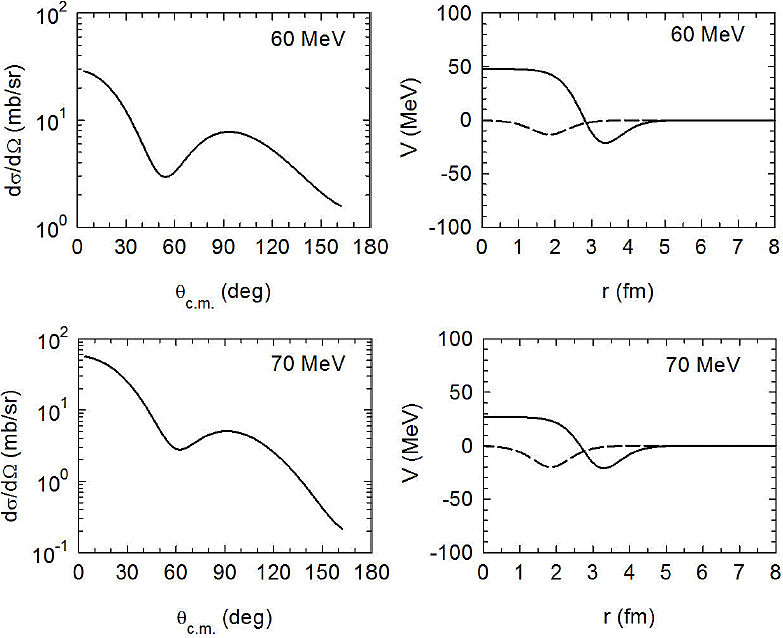
Figure 5 In the left side, predicted elastic differential cross sections calculated at pion’s incident kinetic energies of 60 and 70 MeV. The right side shows the analytical forms of the potentials, real and imaginary represented by solid and dashed lines, respectively, used in predicting these elastic differential cross sections.
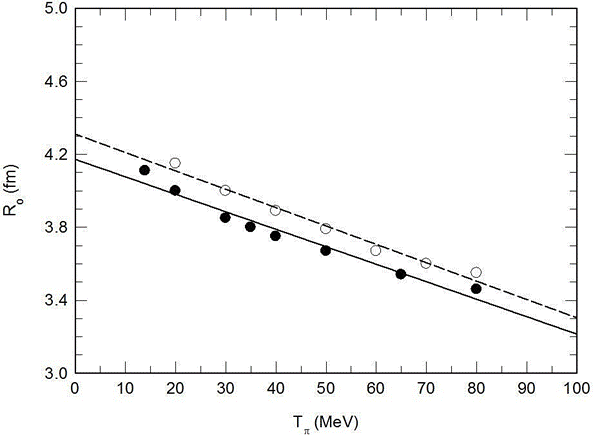
Figure 6 The radius of the real attractive Woods-Saxon potential term versus the pion’s incident kinetic energy. The solid and dashed lines are for π+−12C and π+−16O cases, respectively.
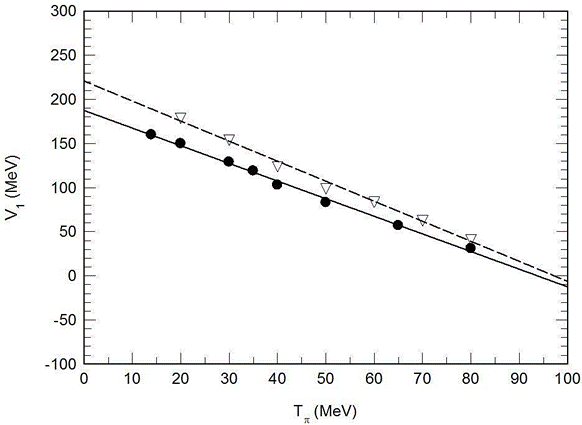
Figure 7 The height of the repulsive real potential term versus the pion’s incident kinetic energy. The solid and dashed lines are for π+−12C and π+−16O cases, respectively.
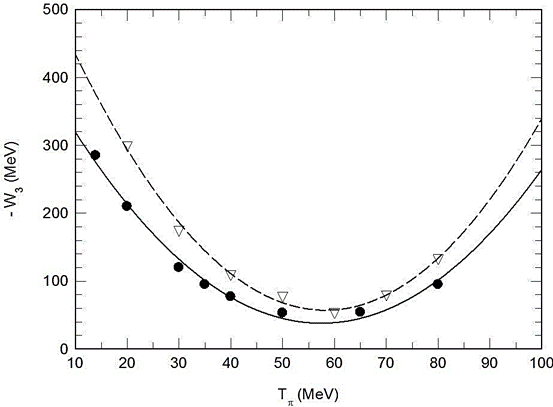
Figure 8 The depth of the imaginary part of the potential versus the pion’s incident kinetic energy. The solid and dashed curves are for π+−12C and π+−16O cases, respectively.
In Fig. 6, the values of R0 at 13.9 and 80 MeV are not on the straight line which may suggest that a better scaling procedure is obtained for a certain energy interval as Tπ< 20 MeV, 20 ≤ Tπ ≤ 80 MeV and 80 ≤ Tπ ≤ 100 MeV. With a reasonable degree of confidence, especially in the energy region 20 ≤ Tπ< 80 MeV, the new suggested scaling method is summarized by a) multiplying the two parameters R0 and V1 by 1.05-1.14, b) multiplying the parameter W3 by 1.30, and c) keeping the other six parameters fixed with R3 follows the A1/3 rule. To become sure and more confident, and with these encouraging results, the analyses of elastically scattered positive pions from 28Si, 232S, 40Ca, 56Fe, 58Ni and 90Zr nuclear targets by scaling from π+ − 12C and π+ − 16O cases will be investigated in the nearest future.
4. Conclusions
In this investigation, the adopted simple local optical potential shows a remarkable success in explaining low-energy π+−12C, 16O elastic differential cross sections data. The role of the inverse scattering theory in guiding to the correct potential parameters is very obvious. For the first time, the use of a scaling method with changes in three free potential parameters R0, V1 and W3 with Tπ has been established. In fact, linear relations for R0 and V1, and quadratic relations for W3 for both π+−12C and π+−16O systems have been obtained. The slopes of R0 and V1 are related to (A2)1/3/(A1)1/3 while W3 is connected to A2/A1. Also the ratio between R3 values for π+−12C and π+−16O cases is found to be the same as (A2)1/3/(A1)1/3 and, as such, to follow the A1/3 rule. With these important findings, this paper will be a contribution to fit further experimental data in the energy range defined here, and shows the success of the scaling method prediction of potential parameters on similar nuclei to describe the pion plus elastic scattering.











 nueva página del texto (beta)
nueva página del texto (beta)


